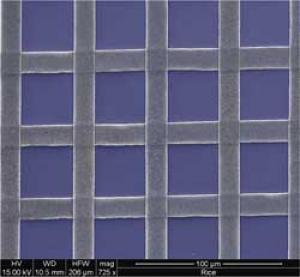The principle of surface adhesion was used to attach carbon nanotubes to the surface

This principle was applied by researchers from Rice University and their research was published this month in the scientific journal ACS Nano. However, in their case, these hairs were "torn" from the gecko and "planted" on the wall itself.
Rice University graduate Cary Pint found a way to move "forests" of highly ordered single-walled carbon nanotubes from one surface to another - any surface - in minutes. The template used to make the nanotubes, with the catalyst particles still attached to them, can be used repeatedly to make more nanotubes, similar to using a rubber stamp with ink. The article, which describes the research, also details a method for a quick and simple determination of the range of diameters in a group of nanotubes prepared by the CVD (chemical vapor deposition) method. Common spectroscopy methods are limited in their ability to observe tubes larger than two nanometers in diameter - and these are the diameters of most of the nanotubes obtained by this method.
"This is important because all the properties of the nanotubes - electrical, thermal and mechanical - change depending on the diameter," says the researcher. "Fortunately, almost every university now has an FTIR (Fourier transform infrared) spectrometer capable of performing these measurements, and will allow for the optimization of the synthesis process of the nanotubes and the development of their various applications."
The team of chemists from Rice University is also investigating ways to make printed layers of these nanotubes fully conductive or fully semi-conductive - a process in which the movement of electrons can be controlled at the nanometer level.
Combining the methods provides a huge step forward for an unlimited number of practical applications including sensors, more efficient solar panels and electronic components. "This direct and industrial method for embedding highly ordered carbon nanotubes on any surface is a significant advance."
The researcher explains how he came to his discovery: "I started "playing" with water vapor to clean the unwanted by-products found between the nanotubes. When I tore off a sample, I noticed that the nanotubes stuck to the picks I was using. "I thought to myself - this is really interesting..."
It turns out that water is the key. After growing the nanotubes, the researcher carved them with a mixture of hydrogen gas and water vapor, a mixture that weakens the chemical bonds between the tubes and the metal catalyst. When embedded again, the nanotubes are flattened and adhere to the new surface via van der Waals binding forces without removing any trace of the catalyst.
The researchers succeeded in developing a method for embedding nanotubes on a wide variety of surfaces that could be reproduced and produced industrially.
An impressive demonstration of this research is the preparation of a two-and-a-half layer array of nanotubes by stamping a series of rows against the surface and then reusing the catalyst to stamp another series of rows at an angle of ninety degrees relative to the first. The process took only fifteen minutes.
The researchers believe that industrial companies will closely examine the new method, through which it is possible to embed electric circuits based on carbon nanotubes inside electronic devices.

3 תגובות
A really strong blow won't tear or move them from their place?
Avi:
What was supposed to be a link to news about the study remained as unlinked text.
It may be an important step towards creating a nanotube that is identical to another. Although who knows - this substance has been deceiving us for 15 years.